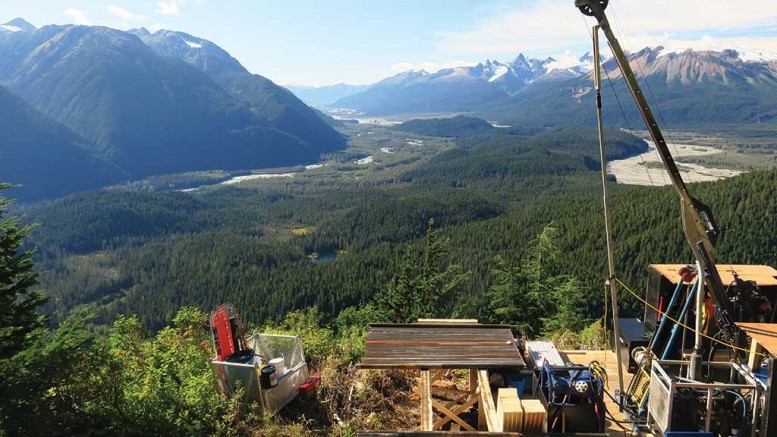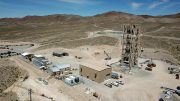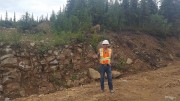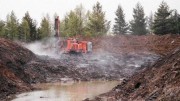TERRACE, B.C. — There’s more than meets the eye when flying over the panoramic landscape of northwest British Columbia’s Golden Triangle. Nestled within the myriad of rocks is a treasure trove of world-class mineral deposits, and Skeena Resources (TSXV: SKE; US-OTC: SKREF) has spent the past few months drilling one of them.
The company has wrapped up a 7,200-metre drill program at its new Snip gold property, 110 km northwest of Stewart, B.C., a historic underground gold mine that saw 1 million oz. production at grades of 25 grams gold per tonne.
The drill campaign is the first activity at Snip since low gold prices forced Homestake Canada to shut down the fly-in, fly-out operation in 1999, after nine years of production.
Skeena optioned the 19.3 sq. km property and mine in March from Barrick Gold (TSX: ABX; NYSE: ABX), whereby the junior can earn 100% by spending $2 million on exploration and issuing 3.3 million shares.
With drill results by Skeena such of 24.44 grams gold per tonne over 3.2 metres and 30.99 grams gold over 4.5 metres, the program looks to be off to a good start.

Flying into Skeena Resources’ Snip gold property in northwest B.C., looking north towards the camp, airstrip, Bronson Creek and the Iskut River. Photo by Ron Nichols.
“I’ve been chasing Snip for the past decade,” Ronald Netolitzky, Skeena chairman and Canadian Mining Hall of Fame inductee, told The Northern Miner at the Terrace airport en route to the Snip property.
“Snip started off with 85% mechanized mining because the vein was over 15 metres thick, but even then the cut-off grade was 18 grams per tonne gold. By the end, it was 80% manual, which is a lot more expensive, and the cost of gold was dropping. Even at a 20-gram-gold cut-off they could’ve mined it for a few more years, but it wouldn’t have been profitable, and big companies don’t like little mines. Today, 18 grams gold is pretty high grade to me,” he says.
Netolitzky knows his way around the region, having been one of the first explorers to recognize the potential of Snip and the Eskay Creek deposit, and asked the helicopter pilot to take the scenic route from Terrace.
The two-hour journey offered views of 300-year-old basalt flows near the Nass River, and a seemingly endless horizon of glacial-covered peaks, and valleys flush with fall colours.
The entrance into Snip is flatter, with the base camp located along the Iskut River, 17 km from a two-year-old hydroelectric plant and an all-season road.
The climate is mild, with the elevation just a few hundred feet above sea level, and the camp located in a valley that extends to the ocean.
The Snip deposit itself is in a subdued flank at the base of a tree-lined mountain.
Cominco geologist Ted Muraro stumbled upon the deposit in 1964.
“Muraro was working in the area and got stuck on the hillside waiting for the helicopter because of the weather,” Netolitzky says as we do a fly-by of the property. “He was probably sliding down on his backside when he came across good-looking rocks. It’s curious to think that if the weather wasn’t bad that day, then Snip may never have been discovered.”
About 60% of the mineralization mined at Snip came from the Twin zone — a 0.5- to 15-metre-thick, high-grade blowout along an east- to southeast-striking shear zone, and divided in two by a barren intrusive.
A quarter of the production came from the 150 zone, a parallel-trending vein found in the deposit’s footwall.
The rest was mined from a similar vein called the 130 zone, and sporadic veins in the hangingwall.
“Infill drilling at Snip was on 100- or 50-metre centres — that’s how continuous the mineralization was,” recalls Ron Nichols, chief geologist for Skeena and exploration geologist at the time of Snip’s discovery. “ I remember we hit some good intersections under the main zone and did follow-up work, and that became the 150 zone.
“To this day there’s still a cloud of high-grade intercepts around the deposit that were never followed up, so our goal this year was to test some of them,” Nichols adds.

Skeena Resources’ chief geologist Ron Nichols (left) and chairman Ron Netolitzky standing in front of a reclaimed adit at the Snip gold project in British Columbia. Photo by Lesley Stokes.
Skeena has focused on footwall zones because of the underlying agreement with Barrick, whereby Skeena can’t drill within 25 metres of historical workings until it gains a 100% interest.
Nichols says that over $2 million has already been spent in this year’s program, and the wheels are in motion to transfer ownership of the property.
However, if Skeena finds more than 2 million oz. gold, Barrick can claw back a 51% interest for three times the cost of Skeena’s exploration expenses.
This year’s 28-hole program identified three areas of mineralization: the 200 footwall zone, the Lamp zone and the Twin West structural corridor, some of which are on display at the project’s core shack.
To give visitors a better perspective on the zones, Nichols thumbs through a number of cross sections that display the results against 280,000 metres of historical drill data that Skeena has been digitizing.
The 200 footwall zone is found 200 metres below the Twin zone’s main historical workings, where the latest results returned 16.24 grams gold over 13.5 metres, 60.7 grams gold over 1 metre and 8.44 grams gold over 1.2 metres.
At the Lamp zone, just east of the Twin zone and nearer to surface, drilling has identified two high-grade veins that returned 59.5 grams gold over 1.4 metres, and 33.07 grams gold over 2.4 metres.
Netolitzky says the Twin West structural corridor — west of the historic Twin West mine workings — is intriguing. Twin West saw 1,500 metres of underground development and 10,000 tonnes of production at 19 grams gold in the operation’s later years.
“Little material was taken out of at Twin West, and the reason why they never did more was because they had a cut-off of 22 grams gold by the time they go over there, so they couldn’t chase it any further,” Netolitzky says.
Skeena’s drilling around Twin West intercepted several parallel veins over a 300-metre strike length, highlighted by 16.01 grams gold over 4.7 metres.

High-grade drill core from the Snip gold project. Photo by Lesley Stokes.
Twin West is considered an extension of the Twin zone, but the two may be separated by a large fault that is expressed as a strong, regional geographical lineament. In fact, the lineament is so pronounced, previous operators built a 1.6 km long airstrip on top.
The only robust geological study of Snip was by David Rhys in 1989 as part of his masters thesis at the University of British Columbia. Rhys suggests in his study that the lineament may also truncate the Red Bluff porphyry — a subeconomic, copper-gold bearing intrusive 400 metres northeast of Snip.
The study also posits that the Red Bluff porphyry may have contributed gold to the Twin zone.
“Some people believe that Twin West may not be the continuation of the Twin zone, it may be a hangingwall zone,” Nichols says. “The fault could have 600 metres offset, or perhaps there’s no offset at all.”
With so many exploration targets at Snip, Netolitzky says he’s eager to begin next year’s program.
“By this time next year we hope to have a year-round operation. Right now we’re drilling at $325 a metre, but when we get underground the holes will be much shorter, and we can drift into a zone more easily and establish the continuity of the mineralization,” he says.
“We’ve got real advantages here over a number of deposits in the region where their locations can be pretty appalling. They’re all doable, they just require a lot of money into infrastructure.
“But I don’t think we have that problem here,” Netolitzky says. “So now the question is, how much did the previous miners leave behind, and what areas have they overlooked?”





Be the first to comment on "Site visit: Skeena hunts for Snip’s forgotten gold"